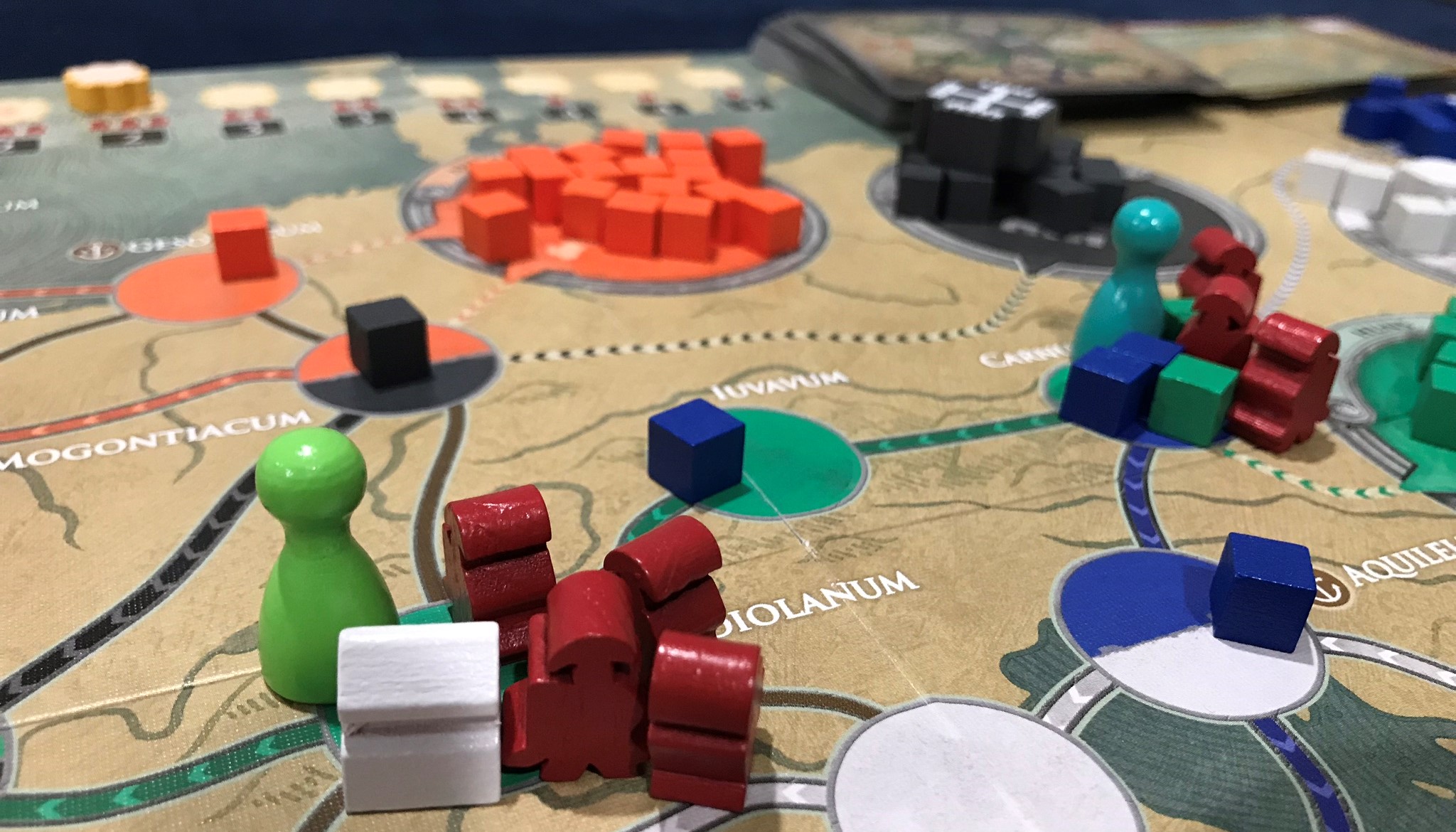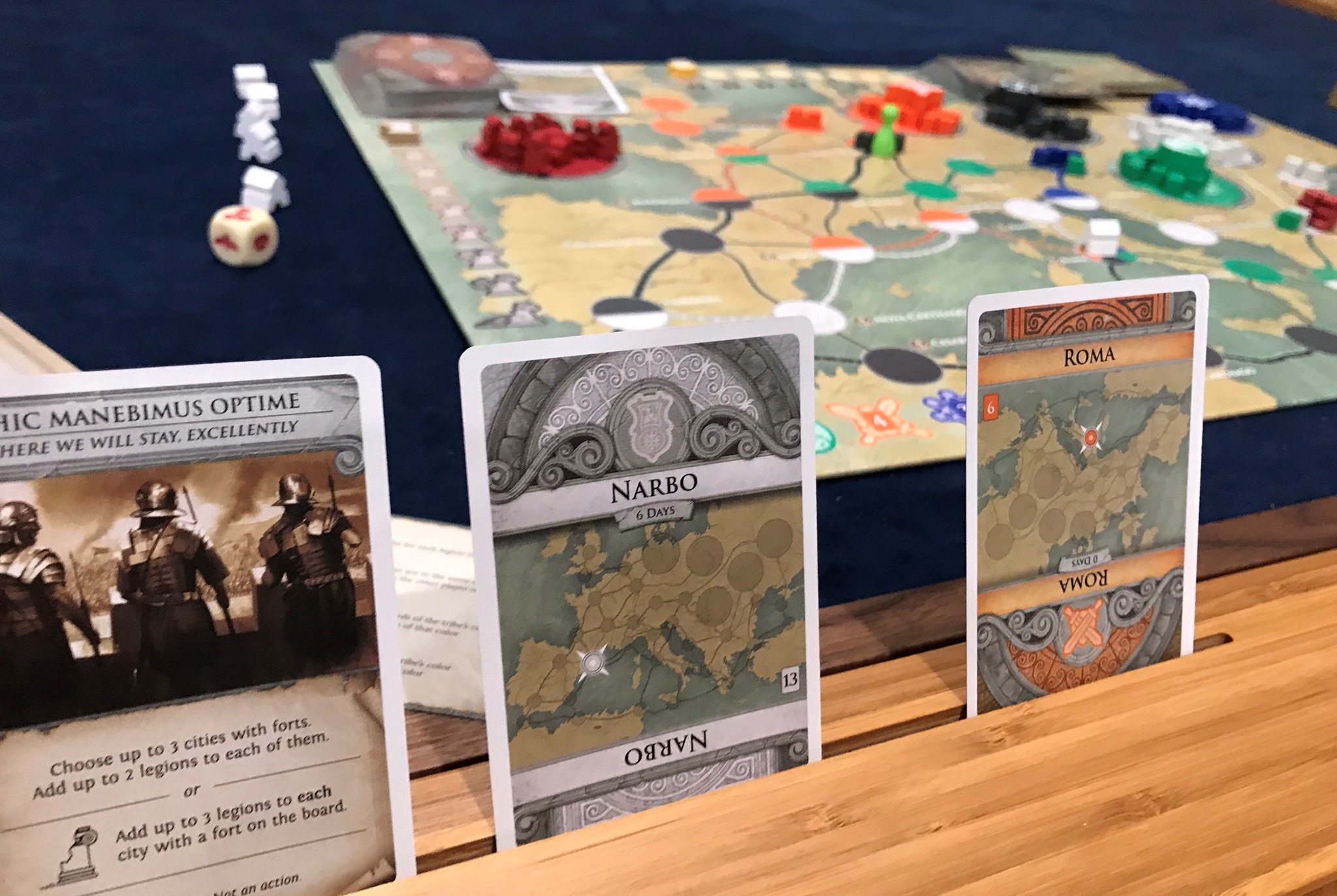The barbarians are rising and there is unrest in the outer cities. The empire – as vast as it is – can still be toppled if the invading hordes are not dealt with. Pandemic: Fall of Rome is the latest title in the Pandemic Survival Series. Venerable Pandemic designer Matt Leacock is joined by Paolo Mori – of Ethnos fame, among others – to bring the familiar formula of Pandemic to Ancient Italy.
In Fall of Rome, players are trying to defend the capital city of Rome from various barbarian tribes. A note in the rulebook states that while accuracy was sacrificed for gameplay purposes, the designers have tried to adequately represent the tribes that would have been assaulting the Roman Empire. Barbarians replace deadly diseases and this title introduces legions to help fight the invaders, but much of the original Pandemic feel is in place.

Like in the base game, players are attempting to prevent the cities dotting the map from accumulating too many colored cubes. In Fall of Rome they represent warriors of the five barbarian tribes. If too many accumulate in a single city then that city is sacked; if too many cities are sacked the game ends. Additionally, if Rome is sacked then the game ends immediately.
Adding to that pressure is a tweak to how cubes are placed on the board. In a normal game of Pandemic, you draw from the Infection deck and add cubes to the appropriate city. Cubes tend to congregate in the same cities over and over in an excellent simulation of the sick getting sicker. In Fall of Rome Invasions occur along a path. Invasion cards show both a final city and a path; cubes move outward from the barbarian strongholds towards the central cities.
This adds a unique element of pressure because removing cubes is trickier in Fall of Rome. You can no longer simply eliminate cubes by virtue of being present; your characters are made up mostly of statesmen and nobles of the Roman class. To clear barbarians from your cities you’ll need to marshal legions and take them with you into battle. A handful of dice will determine the exact outcome so victory is never certain.

These legions can be left behind to garrison cities and help against invasion, though without your presence they are much weaker. If you’re in a city when an Invasion card is drawn then only 1 legion is lost for each cube that must be placed. However, if you’ve left the city to eliminate threats elsewhere all legions can be wiped out by a single barbarian ambush!
The threat of invasion never ceases. Again like the original Pandemic, the main goal is to accumulate city cards of matching colors and turn them in to pacify the threats. Unlike the original, in Fall of Rome, allying with a tribe doesn’t make it peaceful. Allying allows you to recruit barbarians into the army (turning cubes of their color into legions) but Invasion cards will still cause barbarian attacks. It seems peace treaties were harder to negotiate in ancient times.
Pandemic: Fall of Rome feels a lot like a game of resource management. Actions always come at a premium in Pandemic, but the system of invasion routes puts additional pressure on movement. Player roles are highly specialized, which makes teamwork even more critical. I particularly love the opportunity to execute an extremely powerful effect at a steep cost. If 8 cities revolt then the game is over; each player role has the option to move that revolt marker closer to the endgame in exchange for a powerful effect.

These tweaks are enough to provide a welcome new challenge to experienced players of Pandemic, but don’t over complicate the game. Like Pandemic: Iberia – the first in the Survival Series – the gameplay changes feel like strategic wrinkles that make the game different without making it less approachable. The light addition of chance in the battle mechanic also adds an element of nervous excitement that keeps players from feeling like they’re solving a puzzle.
The core engine that drives every iteration of Pandemic is a powerful one. I still maintain that the Epidemic mechanism is one of the best examples of how a smart designer can use game mechanisms to reinforce the setting of a game. Pandemic: Fall of Rome – like the other Survival Series titles – offers the opportunity to explore those classic mechanisms in new lands. We’ve seen a new game each year in this series, and looking forward to the next iteration has become a bit of an annual tradition for me. Fall of Rome did not disappoint, and my anticipation for next year’s title is as high as ever.
Where do you want to see Pandemic go next?
More Pandemic Goodness!
- The 10th Anniversary Edition of Pandemic can be mounted on the wall!
- Check out all the places Pandemic has been in the 10 years it’s been on our tables!
- Pandemic goes Horror in Pandemic: Reign of Cthulhu
Image Credits: Rafael Cordero
In addition to Geek & Sundry, Raf Cordero co-hosts the gaming podcast Ding & Dent. Chat with him on Twitter @captainraffi.